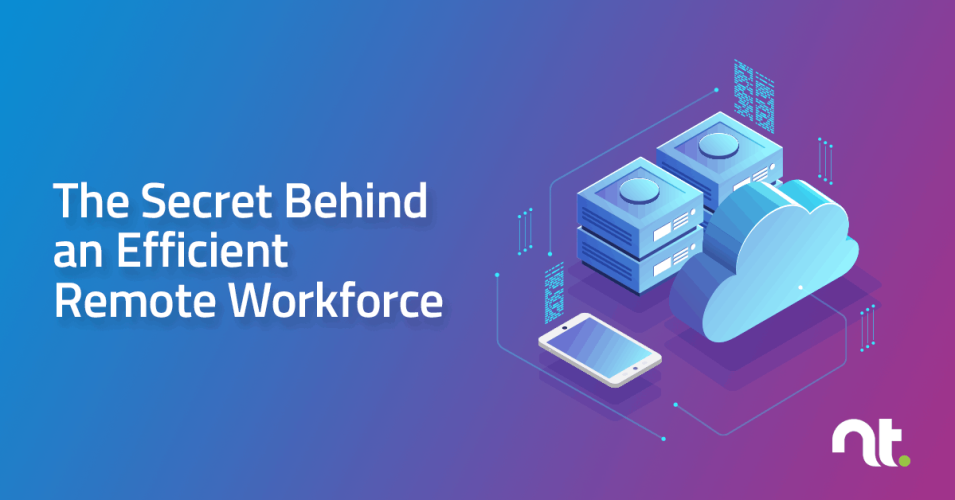READ TIME: 7 MIN

- March 10, 2020
The Secret Behind an Efficient Remote Workforce
Is your business prepared in the event of a disaster or pandemic forcing its staff to work remotely? Let’s not play to the fear of these potential events, but rather the challenges that your business needs to overcome when preparing for these disasters. The challenges that many businesses are facing when developing their remote workforce options within their Business Continuity Plan (BCP) is determining what remote solution would be best suited and scalable for their specific situation. While most employees have access to a laptop or personal computer and can work remotely, the remote options that many businesses utilize today are costly, inefficient and difficult to monitor/scale. To answer the call to that challenge, it may be time for your organization to evaluate a Virtual Desktop Infrastructure (VDI).
Forgive the excess of jargon, but let’s start with a definition of VDI – VDI is the virtualization and hosting of virtual machine(s) (VM), running virtual desktop operating system(s) on dedicated physical servers and made accessible in the cloud. For most this definition may sound a bit confusing, but for those looking to empower a remote workforce, promote budget savings, increase scalability/productivity and enhance security, VDI may be the solution. To expand on this definition, let’s explore each of these benefits in detail:
Empower a Remote Workforce
If you’ve never been exposed to a VDI solution then it may still be a bit confusing. To simplify, let’s play out the VDI process from an end-user perspective:
End-User – From any approved device, (tablets, smartphones, laptops and desktops) launch the remote desktop application securely with the appropriate credentials. Use the launched desktop as you would a normal computer with access to all the required applications and files. You need a reliable internet connection, with adequate bandwidth to connect to the remote desktop. However, after connecting, all other applications that are launched within that desktop application will run off the virtual server’s bandwidth. And worry not, if an employee’s device encounters problems, or encounters a security issue, the company’s data remains safe and secure in the cloud and your employee can find another device and continue where they left off.
Promote Budget Savings
OpEx savings can come from a variety of sources when implementing a VDI solution.
Hardware Savings – Your primary objective is to have a VM running on a dedicated server with a solid internet connection. This may require an initial investment in server hardware or cloud infrastructure in a datacenter which will create long-term hardware savings. In turn, with the computer power housed in the datacenter, the machines accessing the VDI platform can be on lower end of the technology spectrum. The computing power and bandwidth need to reside with your dedicated server, so implementing a BYOD (Bring-Your-Own-Device) policy or issuing devices to your staff may be more than enough. If you’re curious on how much this could save your company, request a quote on a mid-grade laptop vs. a thin client or low-end device for all your staff. You may be pleasantly surprised.
Reduction in IT Man Hours – Your IT staff or IT partner will have more time to focus on your staff and your organization’s substantial issues rather than engaging in tedious work that comes with troubleshooting device-specific problems. Depending on the level of VDI service you subscribe for, new applications, driver installs, OS patches, firmware updates and other various device-specific updates are centralized and need to be addressed once for every user versus the need to update every device individually. Since the OS and specific applications reside via your VDI, your business will experience a reduction in the time spent provisioning new devices.
Increase Scalability/Productivity
Once your VDI solution is implemented correctly with the appropriate procedures in place, all the vital data your business relies on will be centrally located and accessible to your team. Running back ups on your data will be more efficient and complete while reducing cost and complexity compared to backing up data from multiple sources. In addition, your staff’s ability to access applications and documents on approved devices from anywhere will enhance productivity during the most inopportune times. This could be during an off-site sales engagement, international travel or simply working from home. Not only will your company benefit from granting employees access to all their applications and data your staff needs to be successful, but the ability to scale your remote workforce becomes exponentially more simplified.
Enhance Security
Levels of data and application access is often a concern for most businesses. VDI allows different levels of access depending on the needs of your users and the requirements of your business. This allows for more granular access.
The security of your data is paramount and the more control you have over your data, the more your business is protected. With a VDI solution in place, your data is centrally located and can be backed up (and restored) via a single instance. If you choose to utilize a dedicated server in the Cloud, you will reap the benefits that a datacenter affords from a security and availability standpoint. In addition, there is a mitigated risk of your employees housing confidential data on their local systems since all data will be housed securely in the Cloud. The data does not leave your environment but is accessible from anywhere.
Considering recent health news, VDI is more fitting than ever. If you are looking for ways to increase security, simplify your environment and empower your workforce to be productive remotely, please contact NexusTek below.
